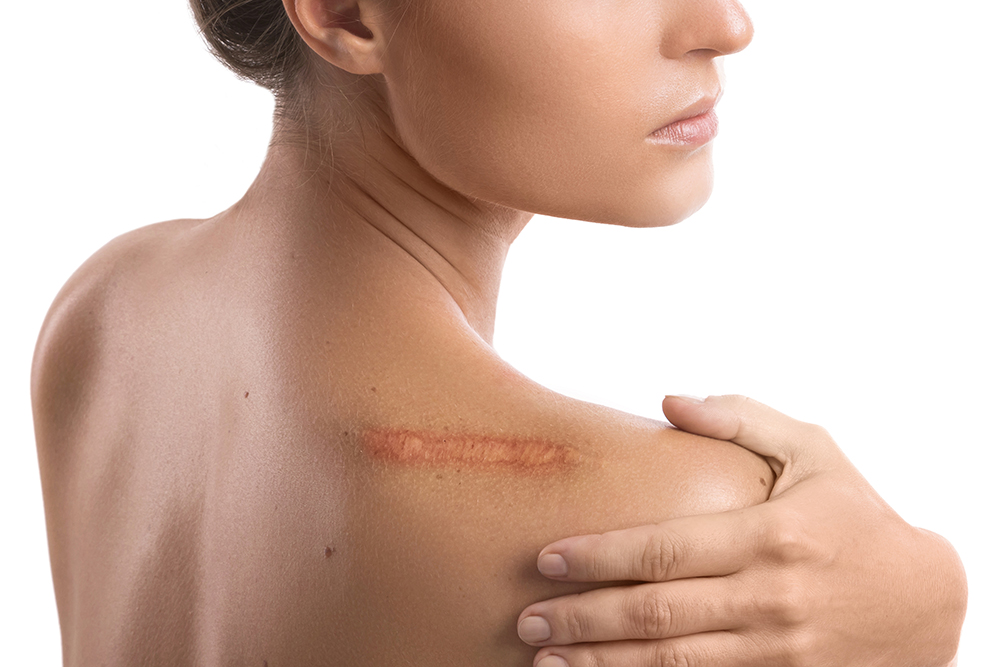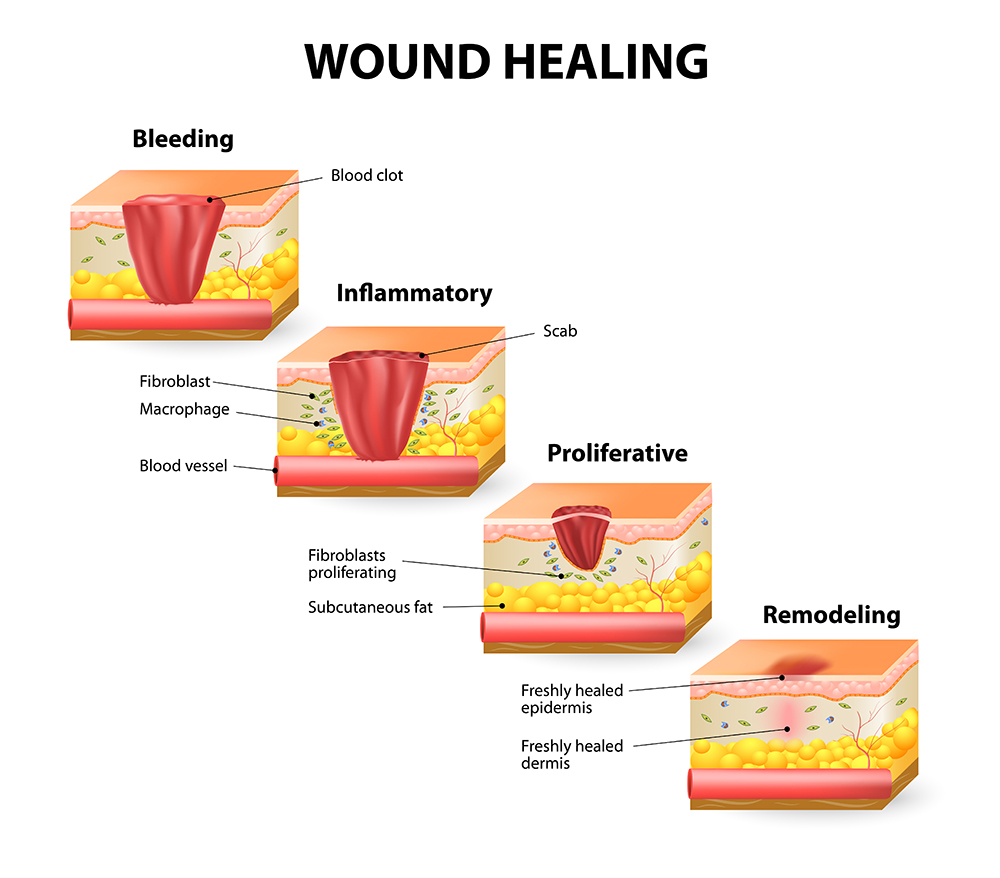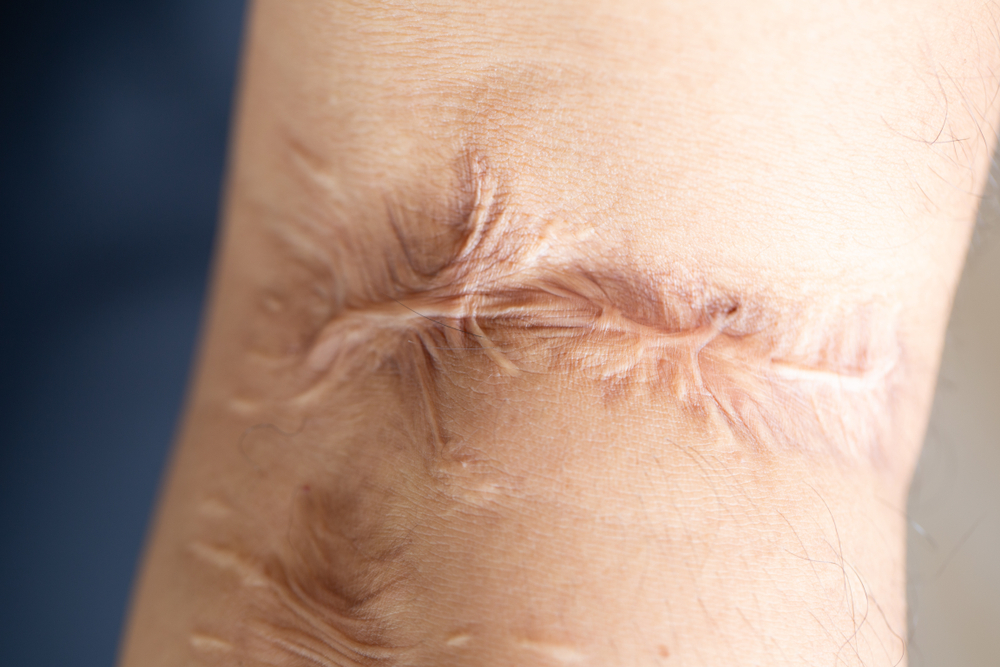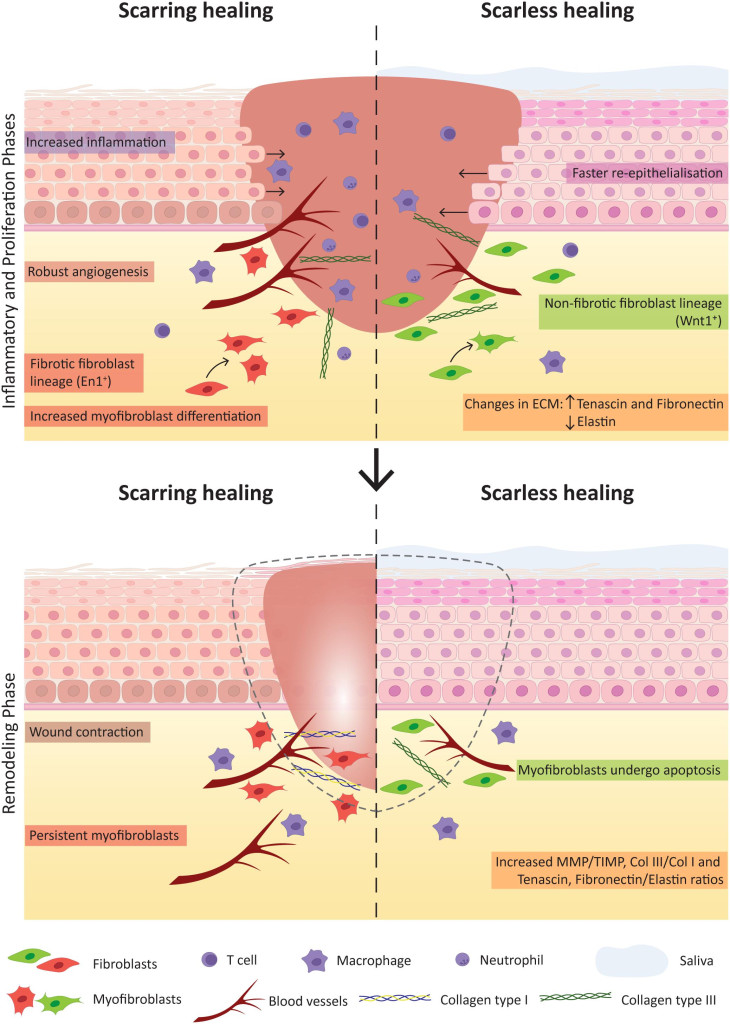Scars are the result of our cells’ actions to heal broken tissue. Different animals, such as lizards, reindeer, and the spiny mouse, can heal without scarring because they perform something call regenerative healing.
We all have scars, whether they’re from a serious accident or just from being clumsy. Our skin miraculously heals from the damage, but the scar will always remind us of that childhood tumble from the swing set.
How does such a scar form? And, more interestingly, what have we learned about the healing process from animals that don’t develop scars?

How Wounds Heal
When you injure your knee, for example, your body activates multiple biochemical pathways almost immediately. Various molecules alert various different types of cells to jump into action.
The first step is to stop the body from losing any more blood through the wound. To do this, the body forms a blood clot. This serves as a scaffold or skeleton for cells that arrive at the wound later. These cells release pro-inflammatory chemicals, which recruit specialized immune cells to fight any pathogens that may have entered the body through the wound.
After this, this skin can begin to repair the cut. Skin cells proliferate and migrate to the site of injury, and then new blood vessels form to restore blood flow to the area.
Later, cells called fibroblasts produce extracellular matrix (ECM – the material between cells) proteins, mainly collagen, which form the bulk of the scar tissue.

Collagen is present in all skin, whether it is scarred or unscarred. Collagen helps maintain the structural framework of the skin tissue. However, collagen in scar tissue is disorganized.
Eventually, upon healing, all the biochemical processes that were activated after the injury get switched off. The cells that came to the site of injury either die (a unique type of cell death called apoptosis) or exit from the wound.
This leaves behind scar tissue consisting mainly of collagen and some other ECM proteins. Rats and mice undergo a similar wound-healing process, while salamander and lizard skin wounds heal without forming scars.

Also Read: Do Different Parts Of The Body Heal At Different Rates?
Not All Animals Scar
Remarkably, the fetus version of you didn’t scar. Human fetuses can heal wounds that leave no trace behind, but we lose this ability once we’re born. In fact, all mammalian embryos that have been studied thus far, including marsupials, mice, rats, sheep, pigs and rabbits, all heal wounds without scar formation.
For some invertebrates, fish and amphibians, birth changes little. They can still heal their wounds without any scars. This type of wound healing process is called regenerative healing. Planaria, zebrafish, and salamanders can all heal regeneratively. Among mammals, spiny mice show regenerative healing. Male reindeer antler skin (velvet) regenerates after wounding, while wounds on the skin of their backs leave scars behind as they heal.
Also Read: Organ Regeneration: Why Can’t Humans Regenerate Organs?
How Do Some Animals Manage To Remain Scarless?
We’re mammals, just like the spiny mouse and reindeer. Why can they heal without scarring in some scenarios, while most other mammals can’t?
The answer, unfortunately, involves various factors. Though scars appear to be collagen that’s not aligned well, the reasons for that structural formation are various, and involve different processes of healing. Inflammatory and immune responses, growth factors, ECM protein deposition, and mechanical stress all govern whether wound healing will leave scars or not.
Inflammatory And Immune-Cell Responses
A higher inflammatory response is correlated with scar formation. The skin of embryos that heal without scars has a minimal inflammatory response, but increased activity of anti-inflammatory chemicals.
This relates to how fibroblasts help rebuild tissue. When the cell builds by suppressing the immune system, then wounds heal without any scars forming, like in fetuses and reindeer antler skin.
The fibroblasts in our skin (after birth( express inflammatory chemicals, so the wounds proceed to heal with scars.

Enzymes And Growth Factors
A particular type of mouse called spiny mice naturally heal without scarring. Scientists have been studying how these mice heal on a molecular level.
A paper published in 2023 found that an enzyme called the ERK (extracellular signal-related kinase) is the difference between scars and no scars in spiny mice. Spiny mice show sustained ERK activity, which promotes skin cell proliferation and induces a regenerative healing response.
Indeed, all wounding leads to an immediate activation of ERK, even our own, but when ERK levels eventually decline in activity within the mouse skin, the mouse skin scars.
Lower levels of certain molecules called growth factors—such as Platelet-Derived Growth Factor (PDGF) and Transforming Growth Factor-β (TGF-β)—are also associated with scarless wound healing.
Mechanical Force
The skin consists of tightly packed cells that give rise to a mechanical force in the skin layer. Upon injury, the way in which the skin surrounding the wound pulls and stretches is one of the factors that determines how much scarring will occur. A higher mechanical stretch stimulates certain biochemical pathways, which lead to the accumulation of collagen and ECM. This situation favors the development of scars.
Also Read: Why Do Healing Wounds Itch?
Animal Size
The size of animals also correlates to stress on their cells. As animals get bigger, the force between their cells increases. A study has identified that these forces in larger animals, such as humans, contribute to scarring. Smaller animals, such as zebrafish and salamanders, do not have such strong forces, and thus show scarless healing.
Why Study Scarless Wound Healing?
The process of wound healing is one of the most complex biological processes in nature. The correct wound healing process involves the activation of several biochemical pathways at the appropriate time. However, once the wound is healed, it is equally important that these pathways be switched off. In some people, an impaired wound-healing process may lead to over-scarring, causing skin hardening and eventual loss of function. This incurs a significant burden on the healthcare sector,
Additionally, scar tissue is inflexible and has less strength than undamaged skin. It also doesn’t contain essential skin structures, such as hair follicles and sweat glands. Thus, the ability to avoiding scarring can help in regenerating the skin and restoring original tissue, considerably improving human health overall.

A Final Word
Wound healing elicits a biochemical response involving multiple cells. Specialized cells called fibroblasts, activated by immune cells called macrophages, secrete ECM proteins like collagen, which forms the bulk of a scar tissue. Some animals can heal wounds without forming a scar. Several factors, including inflammatory and immune responses, enzymes, growth factors, ECM protein deposition and mechanical stress, govern whether wound healing will proceed with or without scars.
How well do you understand the article above!

References (click to expand)
- Xu, X., Gu, S., Huang, X., Ren, J., Gu, Y., Wei, C., … Wang, Z. (2020, January 1). The role of macrophages in the formation of hypertrophic scars and keloids. Burns & Trauma. Oxford University Press (OUP).
- Gurtner, G. C., Werner, S., Barrandon, Y., & Longaker, M. T. (2008, May 14). Wound repair and regeneration. Nature. Springer Science and Business Media LLC.
- Gaire, J., Varholick, J. A., Rana, S., Sunshine, M. D., Doré, S., Barbazuk, W. B., … Simmons, C. S. (2021, January 4). Spiny mouse (Acomys): an emerging research organism for regenerative medicine with applications beyond the skin. npj Regenerative Medicine. Springer Science and Business Media LLC.
- Fröbisch, N. B., Bickelmann, C., Olori, J. C., & Witzmann, F. (2015, October 26). Deep-time evolution of regeneration and preaxial polarity in tetrapod limb development. Nature. Springer Science and Business Media LLC.
- P Martin. (2003) Wound Healing in the PU.1 Null Mouse—Tissue Repair Is ....
- Ud‐Din, S., Volk, S. W., & Bayat, A. (2014). Regenerative healing, scar‐free healing and scar formation across the species: current concepts and future perspectives. Experimental dermatology, 23(9), 615-619.
- Barnes, L. A., Marshall, C. D., Leavitt, T., Hu, M. S., Moore, A. L., Gonzalez, J. G., … Gurtner, G. C. (2018, February). Mechanical Forces in Cutaneous Wound Healing: Emerging Therapies to Minimize Scar Formation. Advances in Wound Care. Mary Ann Liebert Inc.
- Chen, K., Kwon, S. H., Henn, D., Kuehlmann, B. A., Tevlin, R., Bonham, C. A., … Gurtner, G. C. (2021, September 6). Disrupting biological sensors of force promotes tissue regeneration in large organisms. Nature Communications. Springer Science and Business Media LLC.
- Parry, D., & Allison, K. (2022, January). Is the future scarless? – Fibroblasts as targets for scarless wound healing: a narrative review. Scars, Burns & Healing. SAGE Publications.
